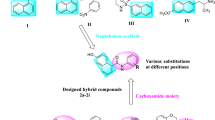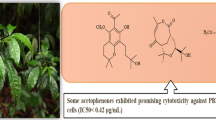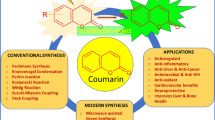Abstract
A series of 4-amino Capsaicin analogs15, 17 and19 were prepared to investigate the bioisosteric effect of 4-amino group, and all these compounds exhibited moderate or weak potency from their analgesic test. From our previous results and others, 4-hydroxyl group, as well as 3-methoxy substituent could be crucial for high analgesic activity. This biological result also shows that the activity is sensitive to alkyl chain length in hydrophobic region and the phenylacetic amides19 are more active than the corresponding urea derivatives17.
Similar content being viewed by others
References Cited
Baek, G. H., Jung, Y. S., Cho, S. J., Seong, C. M. and Park, N. S., Homovanillic amide derivatives as capsaicin analogs and their analgesic activity.Arch. Pharm. Res., 20, 659–661 (1997).
Bayley, H., Standring, D. N. and Knowles, J. R., Propane-1,3-dithiol: a selective reagent for the efficient reduction of alkyl and aryl azides to amines.Tetrahedron Lett., 39, 3633–3634 (1978).
Buck, S. H. and Burks, T. F. The neuropharmacology of capsaicin: review of some recent observations.Pharmacological Reviews, 38, 179–226 (1986).
Gallacher, G., Smith, C. Z. and Hawkes, G. E., Synthesis of a homovanillic acid immunogen that incorporates an isostric group designed to generate antibodies with improved specificaity.Biogenic Amines, 11, 49–62 (1995).
Holzer, P. Capsaicin: cellular targets, mechanisms of action, and selectivity for thin sensory neurons.Pharmacological Reviews, 43, 143–201 (1991).
LaHann, T. R. and Farmer, R. W., Antinociceptive actions of capsacin in rodents.Proc. West. Pharmacol. Soc., 26, 145–149 (1983).
Lim, H.-J., Jung, Y. S., Ha, D.-C., Seong, C.-M., Lee, J.-C., Choi, J., Choi, S. W., Han, M.-S., Lee, K.-S. and Park, N.-S., Synthesis of homavanillic amide derivatives and their analgesic activity.Arch. Pharm. Res., 19, 246–247 (1996).
Park, N.-S., Ha, D.-C., Choi, J.-K., Kim, H.-S., Lim, H.-J. and Lee, B.-Y., N-Aralkylated 4-(2-aminoethoxy) phenylacetamide derivatives as potent analgesic and antiinflammatory agents.Korean J. of Med. Chem., 1, 36–43 (1991).
Park, N.-S., Choi, J.-K., Kim, H.-S., Lee, B.-Y. and Ha, D.-C., Pain reducing effects of 4-amino and 4-(1-piperazinyl) phenylacetamide derivatives.Korean J. of Med. Chem., 3, 116–123 (1993).
Walpole, C. S. J., Wrigglesworth, R., Bevan, S. J., Campbell, E. A., Dray, A., James, I. F., Perkins, M. N., Reid, D. J. and Winter, J., Analogues of capsaicin with agonist activity as novel analgesic agents; structure-activity studies. 1. The aromatic “A-region”.J. Med. Chem., 36, 2362–2372 (1993).
Wrigglesworth, R., Walpole, C. S. J., Bevan, S., Campbell, E. A., Dray, A., Hughes, G. A., James, I., Masdin, K. J. and Winter, J., Analogues of capsaicin with agonist activity as novel analgesic agents: structure-activity studies. 4. Potent, orally active analgesics.J. Med. Chem., 39, 4942–4951 (1996).
Author information
Authors and Affiliations
Rights and permissions
About this article
Cite this article
Cho, S.J., Jung, Y.S., Seong, CM. et al. Bioisosterism: Interchange of 4-OH to 4-NH2 in vanillin or homovanillin ring of capsaicinoids. Arch Pharm Res 22, 184–188 (1999). https://doi.org/10.1007/BF02976544
Received:
Issue Date:
DOI: https://doi.org/10.1007/BF02976544




